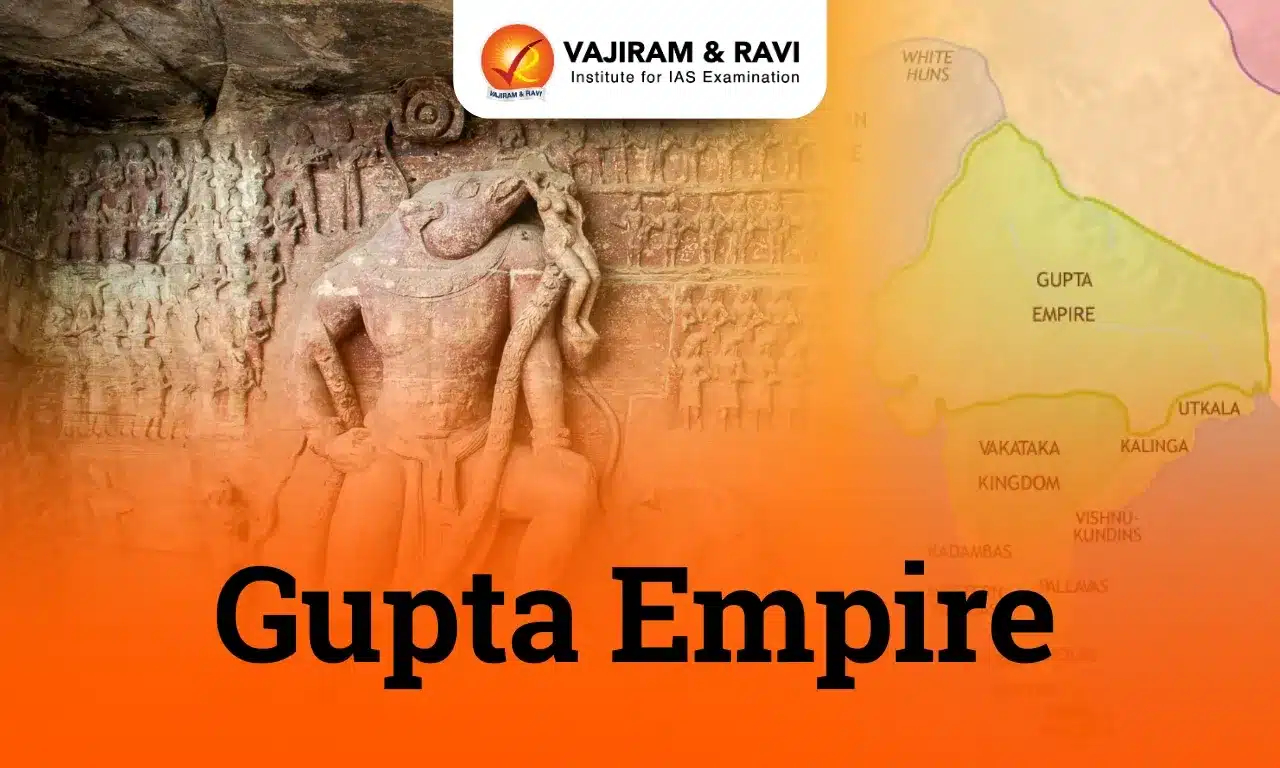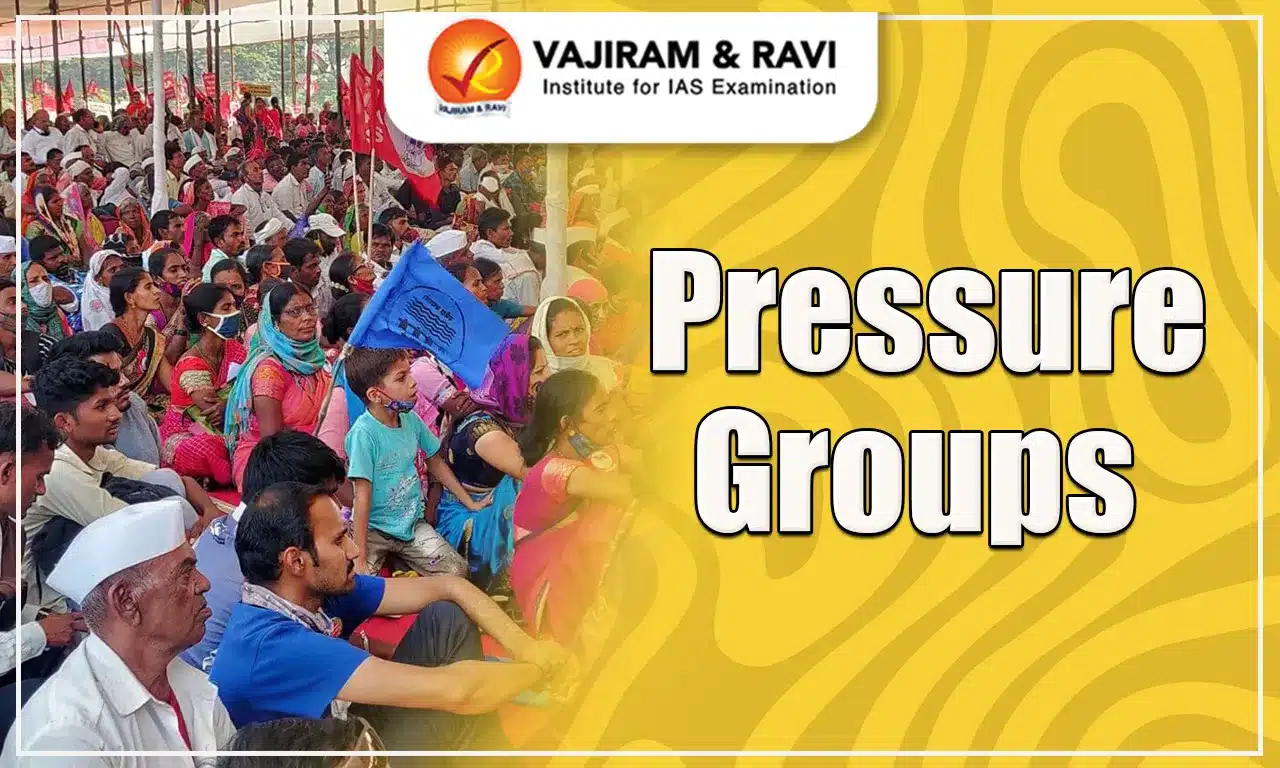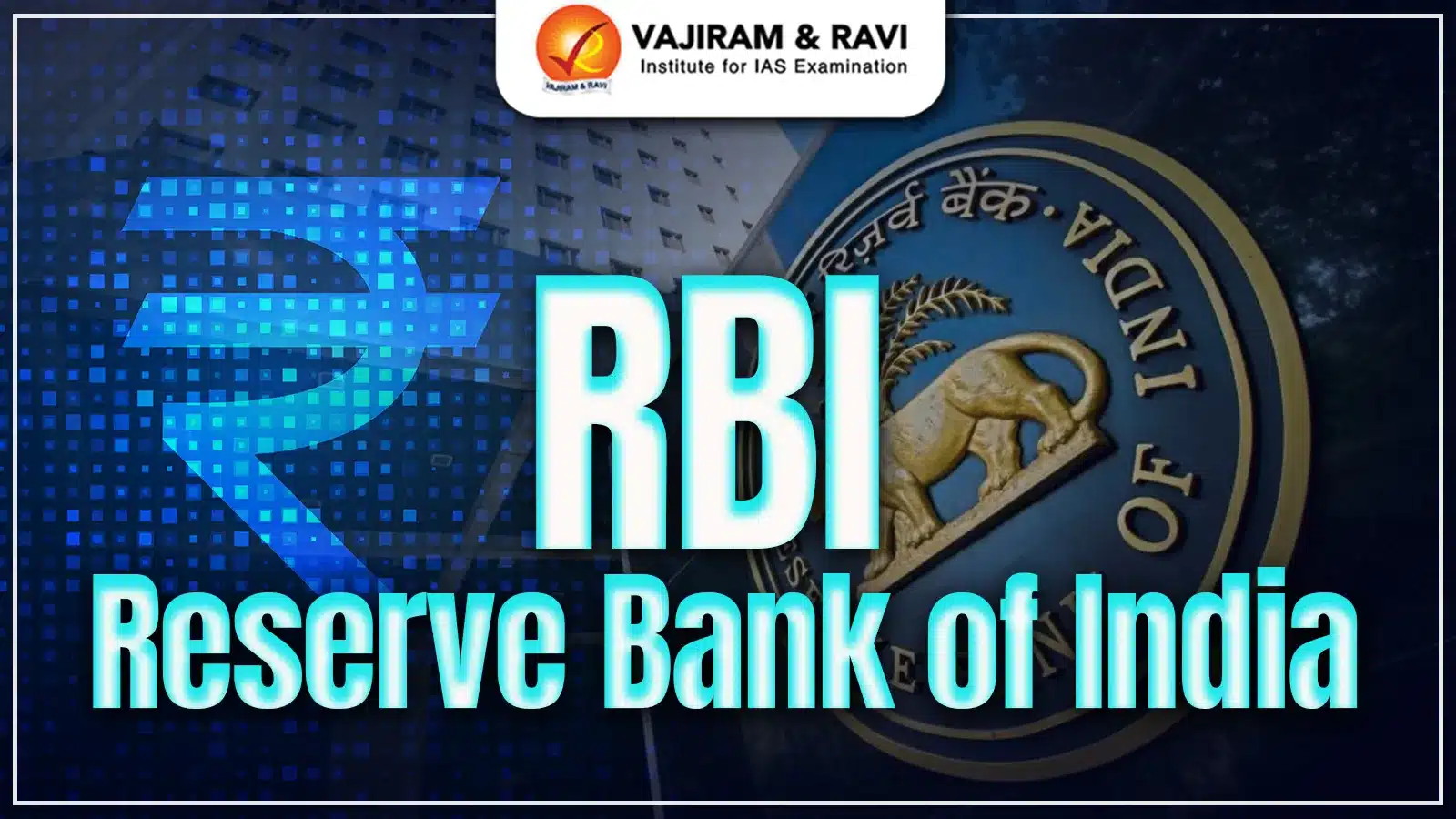The Gupta Empire, from the 4th to the 6th century CE, marked a classical age in North India, renowned for its extensive territory and cultural zenith. Originating from the fertile regions of Eastern U.P. and Bihar, the Guptas leveraged local iron ore to build their empire. The Gupta Empire originated from the kingdom established by Sri Gupta, a skilled leader and strategist. Celebrated for their patronage of the arts, architecture, and literature, their era is often hailed as a ‘Golden Age’, witnessing profound advancements in various fields and leaving an indelible legacy on Indian history.
Gupta Empire Important Rulers
Capable rulers of the Gupta dynasty left a notable impact on the history and influence of the Indian subcontinent. Key Gupta rulers were:
| Ruler Name | Key Points |
| Chandragupta I (320 – 335 CE) |
- The Gupta Empire began with his accession in 319-320 CE. - To strengthen his authority, he entered into a matrimonial alliance with the Lichchhavis of Nepal. - By 321 AD, he expanded his kingdom from the Ganges River to Prayag through conquest. - His kingdom included Bengal, parts of present-day Bihar, with Pataliputra as its capital, and Uttar Pradesh. - He struck coins bearing his and his queen's names. |
| Samudragupta (c. 335/336 – 375 CE) |
- He followed a policy of warfare and conquest. - The Allahabad Pillar Inscription (Prayaga-Prashasti), written in pristine Sanskrit by his court poet Harisena, provides a detailed account of his accomplishments. - The inscription is carved on the same pillar that bears the edicts of the Ashoka. - His rule extended over a significant portion of the Indian subcontinent, directly or indirectly, encompassing empires in Punjab and Nepal to the Pallava kingdom in Kanchipuram. - He minted coins depicting the mythological theme of the Asvamedha (horse sacrifice), symbolizing his role as a restorer. - Title Kaviraja, meaning "king among poets."- due to his skill in poetry |
| Chandragupta II (c. 376 – 413/415 CE) |
- Through his daughter's (Prabhavati) marriage to Rudrasena II, a prince from the Vakataka dynasty in the Deccan, he indirectly ruled over the Vakataka kingdom. - He successfully seized control of the western Malwa and Gujarat regions from Shakas. - An inscription on the iron pillar at Mehrauli (Delhi) indicated that his kingdom encompassed northwestern regions of India and Bengal. - He adopted the titles Simhavikrama and Vikramaditya, symbolising his strength and power. - Minted coins made of silver, copper, and gold (Dinara), with his coins often referred to as Chandra. - The Udaigiri cave inscriptions mentioned his Digvijaya, signifying his conquest of the entire world. - His court had nine renowned intellectuals known as the Navratnas (nine gems), which included:
|
| Kumaragupta Ⅰ (c. 415 – 455 CE) |
- He assumed the titles of 'Shakraditya' and 'Mahendraditya' as part of his royal designations. - He performed Ashvamedha sacrifices. - Establish Nalanda University, which gained global recognition as a prestigious educational institution. - Noteworthy inscriptions from Kumaragupta I's reign include those found in Karandanda, Mandsor Bilsad inscription and Damodar Copper Plate inscription. |
| Skandagupta (c. 455 – 467 CE) |
- He assumed the title of 'Vikramaditya' as part of his royal designation. - An inscription found in Junagarh/Girnar during his reign mentions that his governor Parnadatta undertook the repair of the Sudarshan Lake. - Following his death, several successors such as Purugupta, Kumaragupta II, Buddhagupta, Narasimhagupta, Kumaragupta III, and Vishnugupta were unable to protect the Gupta empire from the Huns. |
Gupta Empire Polity and Administration
The Gupta Empire’s administration was marked by well-organised divisions and a hierarchical structure that ensured effective governance:
King
- The king was the linchpin of the Gupta administration, assuming titles like Paramabhattaraka and Paramesvara, reflecting their divine status akin to deities on Earth as per Smriti texts.
- Duties of the monarch included:
- Formulating state policies for war and peace.
- Safeguarding the realm and its denizens.
- Leading the military in conflicts.
- Supporting the Brahmanas, Sramanas, and the needy.
- Honouring scholars and religious figures.
- Acting as the chief adjudicator, delivering justice based on sacred laws and traditions.
- Appointing key central and provincial officials.
Council of Ministers and Other Officials
- The Mahanandanayaka (Chief Justice) supported the king’s judicial authority.
- Provincial judicial responsibilities were managed by Uparikas, while Vishayapatis oversaw district-level matters.
- Village disputes were typically settled by the headman and elders.
- Notably, Fa-Hien, the Chinese traveller, observed the absence of capital punishment.
- The Mahapratihara (palace guard chief) and Pratihara (ceremonial overseer) were among other significant officials.
- An intelligence network was operational, and Dutakas were tasked with executing land grants.
- The Mahasandhivigrahika managed affairs related to war and peace.
Army
This system ensured a well-maintained and organised military, ready for both defence and expansion when necessary. The military organisation during the Gupta period included:
- King: Led the army during wartime.
- Sandhi-Vigrahika: Minister responsible for peace and war during peacetime.
- Mahabaladhikrita: A high-ranking military official.
- Specialised commanders: Included Pilupati (elephants), Asvapati (horses), and Narapati (infantry).
- Ranabhandagarika: Officer in charge of military supplies and soldiers’ welfare.
Revenue Administration
- Land Revenue and Fines:
- The primary fiscal resources for the Gupta state were land revenue and fines.
- The Akshapataladhikrita oversaw account registers, ensuring the collection of royal dues and the prevention of financial misconduct.
- Pustapala maintained records and verified transactions.
- Taxes and Duties:
- Uparikara tax was imposed on commodities like textiles and oils during intercity trade.
- Merchants paid a commercial tax known as Sulka.
- The king could mandate labour (Visthi), collect land tax (Bali), and solicit additional levies.
- Royal income:
- The monarch’s revenue streams included profits from royal estates, woodlands, treasure discoveries, mineral extraction, and salt production.
Provinces, Districts and Villages
- The Gupta Empire was organised into territorial divisions known as Desas, Rashtras, or Bhuktis, as recorded in historical inscriptions.
- Uparikas, appointed by the king, administered the Bhuktis, which were further segmented into districts or Vishayas. These districts were managed by officials such as Ayuktaka or Vistiyapati, appointed by the provincial governors.
- In Bengal, district administration involved an Adhikarana (office) that included representatives from key local communities like Nagarasresthi (merchant leader), Sarthavaha (caravan chief), Prathama-Kulika (artisan head), and Prathama Kayastha (scribe community head), with Pustapalas handling records.
- Villages were led by a Gramapati or Gramadhyaksha (village headman).
- North Bengal featured administrative units above the village level, termed Astakuladhikarana, which incorporated village representatives such as Gramikas, Kutumbis, and Mahattaras.
- Village Life and Occupations:
- Villages were composed of various professional groups including carpenters, weavers, potters, oil pressers, goldsmiths, and farmers, who likely formed local bodies for managing village affairs.
- Disputes within the village were resolved with the help of Grama-buddhas or village elders, emphasising a community-based approach to governance.
Religious Developments during the Gupta Empire
The Guptas were a Hindu dynasty known for their devout Hinduism, but they allowed Buddhists and Jainists to practice their religions.
- Nalanda University: Founded by Kumaragupta I around 455 CE, it became a renowned centre for learning and is associated with the formalisation of the caste system through endogamy during this era.
- Narasimhagupta Baladitya: Influenced by Mahayana Buddhism, he constructed a sangharama and a 300-foot-high vihara in Nalanda and was celebrated for his patronage of Buddhism.
- Vajra: As the son of Narasimhagupta, he continued the legacy of supporting Buddhism, evidenced by Xuanzang’s accounts of his devout sponsorship.
Gupta Empire Economic & Social Conditions
The Gupta Empire experienced favourable economic and social conditions that fostered cultural and intellectual development. Fa-hsien, a Chinese traveller, provides insights into the economic life of the Gupta Empire. He mentions that Magadha was filled with cities, and the wealthy people supported it through charitable offerings.
Economic Life
- Gupta coinage:
- The Guptas issued the largest number of gold coins known as dinars. These coins were regular in size and weight, depicting Gupta kings and showcasing their love for war and art.
- While not as pure as Kushan coins, Gupta coins servedas a means of payment for military and administrative officials, as well as for land transactions.
- The Guptas also issued silver coins after their conquest of Gujarat, primarily for local trade, and the use of copper coins was limited compared to the Kushans.
- Decline in long-distance trade:
- Compared to earlier periods, there was a declinein long-distance trade during the Gupta period. India's trade with the Eastern Roman Empire, exporting silk, decreased after the Eastern Romans learned silk cultivation from the Chinese.
- Demand for Indian silk abroad had already weakened by the mid-fifth century. Silk weavers from western India migrated to Mandasor in Malwa and shifted to other professions.
- Emergence of priestly landlords:
- In eastern and central Madhya Pradesh, a significant development during the Gupta period was the rise of priestly landlords.
- Land grants made to priests led to the cultivation of new areas but resulted in a lower status for local tribal peasants.
- Forced labour (Vishti) was imposed on peasants in central and western India.
- However, agricultural knowledge improved in the tribal regions of central India due to the involvement of Brahmanas, and more land was brought under cultivation.
Social Life
- Brahmana supremacy and Gupta rulers:
- Large-scale land grants to Brahmanas suggest a rise in Brahmana's dominance during the Gupta period.
- The Guptas, originally believed to be vaishyas,were recognised as Kshatriyas by the Brahmanas.
- The Brahmanas portrayed the Gupta kings as god-like figures, legitimising their position and establishing the Guptas as strong supporters of the Brahmanical order.
- Proliferation of castes:
- The number of castes increased due to the assimilation of foreigners and tribal people. Each group of foreigners was considered a caste, often with Kshatriya status.
- The Hunas, who arrived in the fifth century, eventually became recognized as one of the Rajput clans.
- Land grants to tribal chiefs resulted in the formation of new castes, with the ordinary tribal members assigned a lower origin.
- Improved status of Shudras:
- Shudras experienced some improvements during this period. They were permitted to hear recitations of the Ramayana, Mahabharata, and Puranas, which represented the Kshatriya tradition.
- Shudras could worship Krishna and perform certain domestic rites, which contributed to the economic status of the Shudras. From the seventh century onwards, shudras were mainly associated with agriculture.
- Increase in untouchables:
- The number of untouchables, particularly the chandalas, grew during the Gupta period.
- The chandalas, mentioned by Fa-Hsien, lived outside the village and were involved in the meat and flesh trade. The chandalas' disabilities became noticeable, and their presence attracted attention.
- Status of women:
- Women of higher varnas did not have independent sources of livelihood, unlike women of lower varnas.
- Women from vaishya and Shudra backgrounds engaged in agricultural operations and domestic services, granting them more freedom.
- In Gupta times, members of higher varnas acquired more land, becoming more polygamous and treating women as property.
- Widow immolation was first recorded in AD 510, but post-Gupta law books allowed widow remarriage in certain circumstances.
- Women's property rights:
- The oldest Smritis recognised gifts received by brides during marriage as their property. Gupta and post-Gupta law books expanded the scope of these gifts, known as strident.
- Women were allowed to sell and mortgage their immovable property, suggesting they received shares in landed property. However, patriarchal communities generally did not allow daughters to inherit landed property.
- Niyoga and widow remarriage:
- Niyoga, the practice of a younger brother or kinsman marrying the widow of the elder brother, was practised in Vedic times but not allowed during Gupta and earlier periods.
- Widow remarriage was also prohibited for higher varnas but permitted among the shudras, who could practice both niyoga and widow remarriage.
Gupta Empire Decline
The mighty Gupta Empire stumbled under the rule of Skandagupta and his successors. There are several reasons which could be attributed to the same:
- Huna Invasions: The Huna people, also known as Huns, invaded Gupta territory, inflicting severe damage on the empire. By the 6th century CE, the empire had been fragmented into provincial states due to attacks from various directions.
- Political Factors: Feudal states, decreased trade, weak leadership, and invasions were political factors contributing to the decline. Internal rebellions, foreign interventions, and dynastic feuds also played a role in the Gupta Empire's downfall.
- Internal conflicts: Major conflicts and divisions among the royal clans destabilized the rule and weakened the empire. The Huns successfully colonised regions such as Gandhara, Punjab, Gujarat, and Malwa, eroding the control of the Gupta Empire.
- Religious shift: Gupta rulers started following Buddhist practices instead of Hinduism, which further weakened the empire.
- Neglect of military conquests: The Guptas shifted their focus away from military conquests and expansion, contributing to the decline of the empire.
- Incompetent rulers and external pressures:
- Skandagupta, Chandragupta II's grandson, depleted the empire's resources and wealth through his vicious conduct, marking the beginning of the Gupta Empire's decline.
- Flawed rulers and retaliation from local and foreign powers further weakened the Gupta Empire.
- Unity and sufficient resources were crucial for maintaining the empire, which was lacking.
- Economic Factors:
- Setbacks in western India and the loss of trading opportunities with the Mediterranean contributed to economic challenges.
- Failure to implement land reform, floods, crop failures, and natural disasters affected the economy.
- The migration of the silk weavers' establishment from Gujarat to Malwa, the lack of demand for their products, and fading trade perks in Gujarat impacted the empire.
- The debasement of gold content in coins during the 5th century impacted the empire's gold reserves and contributed to its decline.
Gupta Empire UPSC PYQs
Question 1: How do you justify the view that the level of excellence of the Gupta numismatic art is not at all noticeable in later times? (UPSC Mains 2017)
Question 2: Which one of the following ports handled the North Indian trade during the Gupta period? (UPSC Prelims 1999)
- Tamralipti
- Broach
- Kalyan
- Cambray
Answer: (a)
Question 3: There are only two known examples of cave paintings of the Gupta period in ancient India. One of these is paintings of Ajanta caves.Where is the other surviving example of Gupta paintings? (UPSC Prelims 2010)
- Bagh Caves
- Ellora Caves
- Lomas Rishi Caves
- Nasik Caves
Answer: (a)
Question 4: With reference to forced labour (Vishti) in India during the Gupta period, which one of the following statements is correct? (UPSC Prelims 2019)
- It was considered a source of income for the State, a sort of tax paid by the people
- It was totally absent in the Madhya Pradesh and Kathiawar regions of the Gupta Empire
- The forced labourer as entitled to weekly wages.
- The eldest son of the labourer was sent as the forced labourer.
Answer: (a)
Question 5: With reference to the period of Gupta dynasty in ancient India, the towns Ghantasala, Kadura and Chauf were well known as (UPSC Prelims 2020)
- Ports handling and foreign trade
- Capital of powerful kingdoms
- Places of exquisite stone art and architecture
- Important Buddhist pilgrimage centres
Answer: (a)
Last updated on November, 2025
→ Check out the latest UPSC Syllabus 2026 here.
→ Join Vajiram & Ravi’s Interview Guidance Programme for expert help to crack your final UPSC stage.
→ UPSC Mains Result 2025 is now out.
→ UPSC Notification 2026 is scheduled to be released on January 14, 2026.
→ UPSC Calendar 2026 is released on 15th May, 2025.
→ The UPSC Vacancy 2025 were released 1129, out of which 979 were for UPSC CSE and remaining 150 are for UPSC IFoS.
→ UPSC Prelims 2026 will be conducted on 24th May, 2026 & UPSC Mains 2026 will be conducted on 21st August 2026.
→ The UPSC Selection Process is of 3 stages-Prelims, Mains and Interview.
→ UPSC Result 2024 is released with latest UPSC Marksheet 2024. Check Now!
→ UPSC Prelims Result 2025 is out now for the CSE held on 25 May 2025.
→ UPSC Toppers List 2024 is released now. Shakti Dubey is UPSC AIR 1 2024 Topper.
→ UPSC Prelims Question Paper 2025 and Unofficial Prelims Answer Key 2025 are available now.
→ UPSC Mains Question Paper 2025 is out for Essay, GS 1, 2, 3 & GS 4.
→ UPSC Mains Indian Language Question Paper 2025 is now out.
→ UPSC Mains Optional Question Paper 2025 is now out.
→ Also check Best IAS Coaching in Delhi
Gupta Empire FAQs
Q1. What was the extent of the Gupta Empire's territory?+
Q2. Why is the Gupta Period considered the "golden age" of Indian history?+
Q3. What were the major achievements of the Gupta Empire?+
Q4. Who were some notable rulers of the Gupta Empire?+
Q5. What was the social structure during the Gupta Empire?+
Tags: gupta empire quest

















